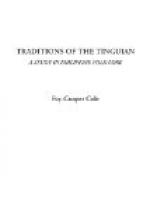While they thus appear to be to a certain extent under the control of the spirits and to be surrounded by animals and inanimate things with human intelligence and speech, the people of these “first times” possess great power over nature: Time and space are annihilated, for at their will daylight comes at once (p. 150), or they are transported to a place in an instant (p. 92). At their command people appear: Kanag creates betel-nut trees, then cuts the fruit into bits, which he sows on the ground. From these come many people who are his neighbors, and one of whom he marries (p. 121). The course of nature is changed: A field is planted in an instant; the crops mature in a few days, and the grain and fruits take themselves to the store-house (p. 150). A strike-a-light turns into a hill which impedes pursuers [35] (p. 75), while a belt or headaxe serves as a ferry across a body of water (p. 84). A storm is called upon to carry a person or a building to a distance (p. 121), and a spring is created by killing an old man (p. 60). [36] Prepared food appears at a word; a stick when cooked becomes a fish, and though it is repeatedly broken and served it always appears ready for service at meal time (p. 33); a small jar containing a single grain of rice supplies an abundance of food; another jar no larger than a fist furnishes drink for a company and still remains a third full; while a single earring fills a pot with gold [37] (pp. 47, 119, 123).
Quite as easy as the creation of beings is the causing of sleep or death. All the people of a village are put to sleep at the will of a single person (p. 145) and Albaga—while still at a distance—causes the death of Aponibolinayen (p. 44). At a word of command the spears and headaxes of the people of Kadalayapan and Kaodanan go out and kill great numbers of the enemy, and the heads and booty take themselves in orderly fashion to towns of their new owners (pp. 66, 75). Many methods of restoring the dead to life are employed; spittle is applied to the wounds, or the victim is placed in a magic well, but the common method is for the hero “to whip his perfume,” [38] whereupon the dead follow his commands (pp. 152, 157).
The birth of a child, to a woman of these times, is generally preceded by an intense itching between the third and last fingers, and when this spot is pricked the child pops out “like popped rice.” [39] Its growth is always magical, for at each bath its stature increases by a span (p. 102). Within a few days the baby is a large child and then begins deeds of valor worthy of the most renowned warriors (pp. 95, 96).




